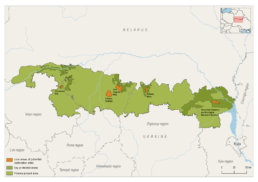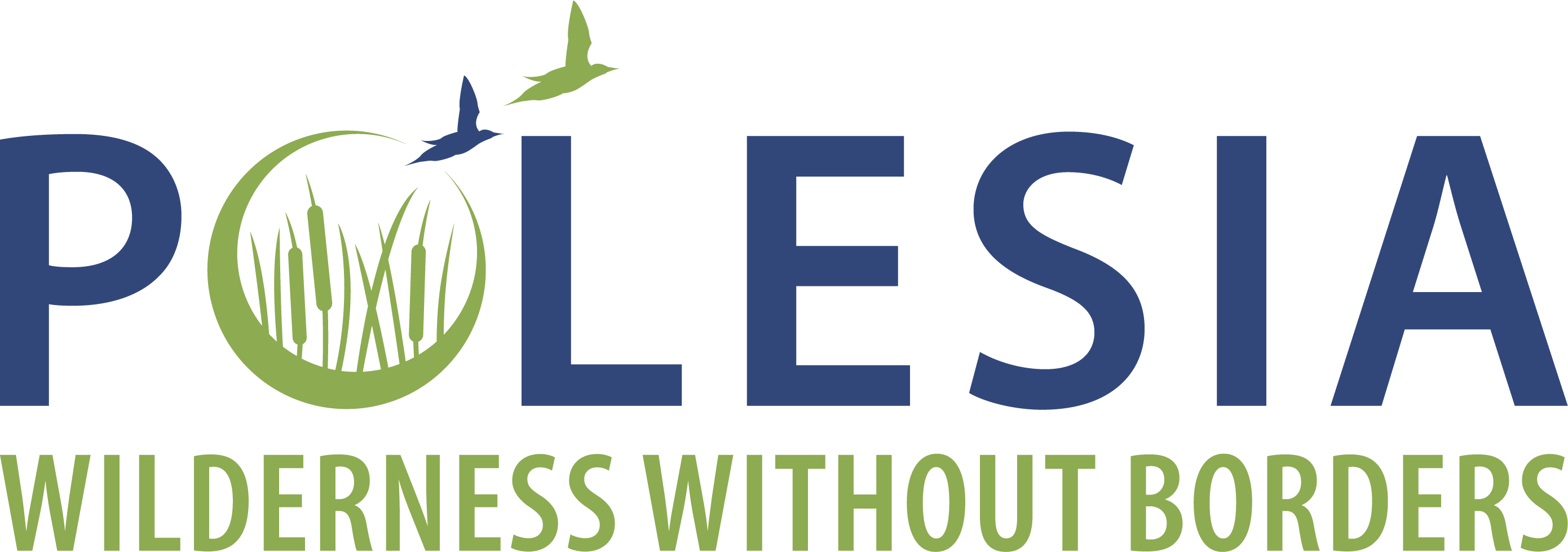Nobelskyi National Park
This remarkable area consists of three parts. The first section follows the lower part of the Stokhid River for about 90 km, covering also fragments of forests next to the river’s floodplain. The second section covers a 30 km stretch of the Pripyat River valley forming an important ecological corridor that connects protected areas in Ukraine (Pripyat-Stokhid National Park) and Belarus (the Prostyr area of special conservation interest). Within it lies the large lake Nobel and several smaller lakes. The third, southernmost, section of the Nobelskyi National Park comprises a large fragment, several big patches, and many small patches of a forest-and-bog complex scattered across the watershed between the Stokhid and the Styr rivers.
This area represents a typical Polesian landscape, featuring waterlogged river floodplains, marshes, forests, and large polder systems.
Inside the national park, the Stokhid and Pripyat rivers run wild and untouched. Their channels are entirely natural, meandering across the land, splitting into numerous branches and flow paths, and their riverbanks seamlessly blend into the surrounding marshes.

Country: Ukraine
Area: 25,318.0 ha
National protection status: National Park
International protection status: Emerald Network* (UA0000168) - Stokhyd-Nobel (57,000 ha); IBA (UA007) - Stokhod river valley (17,800).
*The following description relates to Stokhyd-Nobel Emerald Network site.
2 major rivers
preserved in the fully natural state
21 key habitats
found here are included
in Resolution #4
of the Standing Committee to the Bern Convention
>60 species
included into resolution #6 of the Standing Committee to the Bern Convention occur here
Land cover

Forests, including forests on bogs

Mires

Ponds, watercourses

Meadows
Biodiversity and natural values

Habitats
The area is peculiar for a diversity of forest, meadow, and wetland habitats. 21 of them are listed in the Resolution No 4 of the Standing Committee to the Bern Convention as those requiring special protection measures. The area is of exceptional importance for conservation of the following natural habitats in Ukraine:
Aquatic and Wetland Habitats
- Floating Plant Communities (3150): Floating frogbit rafts, Floating water-soldier rafts, Floating Salvinia natansmats, Floating bladderwort colonies, Floating Aldrovanda vesiculosa (Waterwheel Plant) communities;
- Slow-Flowing Rivers (3260): Mesotrophic vegetation of slow-flowing rivers;
- Marshes & Mires: Transition mires and quaking bogs (7140), Beds of large sedges (normally without free-standing water).
Woodland Habitats
- Riverine willow woodland (91E0),
- Sphagnum birch woods (91D0),
- Nemoral bog conifer woodland (91D0);
Grassland and Meadow Habitats:
- Low and medium altitude hay meadows (6510),
- Moist or wet eutrophic and mesotrophic grassland (6440).



Fauna
Over 60 species occurring here are included into Resolution No 6 of the Standing Committee to the Bern Convention.
The diversity of mammal species in the area includes the European Beaver (Castor fiber), the Common Otter (Lutra lutra), the Murin des Marais (Myotis dasycneme), the European Mink (Mustela lutreola).
The area is a very important habitat of a number of fish species: the Lake Minnow (Phoxinus percnurus), the Ukrainian Brook Lamprey (Eudontomyzon mariae), the European Weatherfish (Misgurnus fossilis), the Ziege (Pelecus cultratus), the Spined Loach (Cobitis taenia), European Bitterling (Rhodeus sericeus amarus), аs well as of reptiles and amphibians: the European
Pond Turtle (Emys orbicularis), the Crested Newt (Triturus cristatus) and the Fire-bellied Toad (Bombina bombina).
Rare insect species’ inhabit the area, such as the Large White-faced Darter (Leucorrhinia pectoralis), the Water Beetle (Graphoderus bilineatus), the Scarce Fritillary (Hypodryas maturna), the Large Copper (Lycaena dispar), and the False Ringlet (Coenonympha oedippus).

Birds
The area is of great importance for a number of bird species, for instance, the Aquatic Warbler (Acrocephalus paludicola), the Great Snipe (Gallinago media), the Greater Spotted Eagle (Aquila clanga), European Roller (Coracias garrulous), the Red-backed Shrike (Lanius collurio), the Little Bittern (Ixobrychus minutus), the Bittern (Botaurus stellaris), the Black Tern (Chlidonias niger), the Whiskered Tern (Chlidonias hybridus), the Little Crake (Porzana parva), the Spotted Crake (Porzana porzana), the Three-toed Woodpecker (Picoides tridactylus), the White Stork (Ciconia ciconia), the Montagu’s Harrier (Circus pygargus), the Corncrake (Crex crex), the Middle Spotted Woodpecker (Dendrocopos medius), the Barred Warbler (Sylvia nisoria).
Besides, the area is important for nesting of several other birds of prey and wetland birds, such as the Marsh Harrier (Circus aeruginosus), the Black Stork (Ciconia nigra), the Kingfisher (Alcedo atthis), the Black Kite (Milvus migrans), the Black Grouse (Tetrao tetrix tetrix), the Ruff (Philomachus pugnax), the Terek Sandpiper (Xenus cinereus) etc.

The most important impacts and threats

Logging and dead wood removal

Illegal hunting and fishing

Old drainage systems

Illegal amber mining
The wetland ecosystems suffer from the existing polders, both inside and outside the national park, and their possible reconstruction. Meadow ecosystems are degraded by scrub encroachment due to the cessation of haying and grazing, conversion of meadows to arable land, cereal cultivation, spring and autumn burning. Forest habitats and species are threatened by clear-cutting, sanitary felling, removal of dead wood, and forest plantation. Pollution by domestic waste, illegal fishing and hunting are among the negative factors affecting the entire area of the national park. The southern part of the Nobel National Nature Park has been severely degraded by illegal amber mining.
Conservation measures
About 80% of the area lies within the Nobelskyi National Nature Park and Stokhid Landscape Reserve. For these areas (overlapping with the national park and the reserve) timber harvesting, clearcut logging, incremental and gradual felling, hunting, drainage are banned, whereas some other restrictions are imposed.
Detailed inventory of the conservation values (species’ habitat and natural complexes) is necessary, and ensuring their protection by creating special protection zones.
Our activities in the area
Сameratraps were installed to study current distribution and abundance of big mammals in the project region.
Since the beginning of the war, funds were raised for the support of Polesian PAs that have been directly affected by the war or need support in accommodation of Internally Displaced People. Nobelskyi NP was receiving regular financial support for covering expenditures like fuel, vehicle spares and maintenance, building maintenance, services (rent, telecommunications, etc.) and office supplies.



The project “Polesia – Wilderness Without Borders” is part of the Endangered Landscapes & Seascapes Programme and is funded by Arcadia. The project is coordinated by Frankfurt Zoological Society (FZS).

